Comparison between Fractal and Statistical Approaches to Model Size Effects in VHCF
Abstract
1. Introduction
2. Methodologies
2.1. The Fractal Approach
2.2. A New Statistical Approach
3. Comparison with Experimental Results
3.1. EN-AW6082 Aluminum Alloy
3.2. The Fractal Approach
3.3. The New Statistical Model
3.4. Comparison between the Two Theoretical Models
4. Conclusions
Author Contributions
Funding
Data Availability Statement
Conflicts of Interest
Abbreviations
| UFTM | Ultrasonic fatigue testing machine |
| VHCF | Very-High Cycle Fatigue |
| P-S-N | Probabilistic stress-life |
| MLM | Maximum Likelihood Method |
| P-S*-N | Probabilistic fractal stress-life |
| CDF | Cumulative distribution function |
| SEM | Scanning Electron Microscope |
| K-S | Kolmogorov-Smirnov |
| C-vM | Cramer-von Mises |
| A-D | Anderson-Darling |
| GoF | Goodness of fit |
| Q-Q | Quantile-Quantile |
| FEA | Finite Element Analyses |
| P-P | Probability-Probability |
References
- Fitzka, M.; Schönbauer, B.M.; Rhein, R.K.; Sanaei, N.; Zekriardehani, S.; Tekalur, S.A.; Carroll, J.W.; Mayer, H. Usability of Ultrasonic Frequency Testing for Rapid Generation of High and Very High Cycle Fatigue Data. Materials 2021, 14, 2245. [Google Scholar] [CrossRef] [PubMed]
- Schneider, N.; Bödecker, J.; Berger, C.; Oechsner, M. Frequency effect and influence of testing technique on the fatigue behaviour of quenched and tempered steel and aluminium alloy. Int. J. Fatigue 2016, 93, 224–231. [Google Scholar] [CrossRef]
- Ilie, P.; Lesperance, X.; Ince, A. Development of an ultrasonic fatigue testing system for gigacycle fatigue. Mater. Des. Process. Commun. 2019, 2, e120. [Google Scholar] [CrossRef][Green Version]
- Lesperance, X.; Ilie, P.; Ince, A. Very high cycle fatigue characterization of additively manufactured AlSi10Mg and AlSi7Mg aluminium alloys based on ultrasonic fatigue testing. Fatigue Fract. Eng. Mater. Struct. 2021, 44, 876–884. [Google Scholar] [CrossRef]
- Invernizzi, S.; Montagnoli, F.; Carpinteri, A. Fatigue Assessment of the Collapsed XXth Century Cable-Stayed Polcevera Bridge in Genoa. Procedia Struct. Integr. 2019, 18, 237–244. [Google Scholar] [CrossRef]
- Invernizzi, S.; Montagnoli, F.; Carpinteri, A. The collapse of the Morandi’s bridge: Remarks about fatigue and corrosion. In Proceedings of the IABSE Symposium, Wroclaw 2020: Synergy of Culture and Civil Engineering—History and Challenges, Wroclaw, Poland, 7–9 October 2020; pp. 1040–1047. [Google Scholar]
- Invernizzi, S.; Montagnoli, F.; Carpinteri, A. Corrosion Fatigue Investigation on the Possible Collapse Reasons of Polcevera Bridge in Genoa. Lect. Notes Mech. Eng. 2020, 151–159. [Google Scholar] [CrossRef]
- Invernizzi, S.; Montagnoli, F.; Carpinteri, A. Very High Cycle Corrosion Fatigue Study of the Collapsed Polcevera Bridge, Italy. J. Bridge Eng. 2022, 27, 04021102. [Google Scholar] [CrossRef]
- Ye, W.-L.; Zhu, S.-P.; Niu, X.-P.; He, J.-C.; Wang, Q. Fatigue Life Prediction of Notched Components Under Size Effect Using Stress Gradient-Based Approach. Int. J. Fract. 2021, 234, 249–261. [Google Scholar] [CrossRef]
- Zheng, Z.; Zhan, M.; Fu, M.W. Microstructural and Geometrical Size Effects on the Fatigue of Metallic Materials. Int. J. Mech. Sci. 2022, 218, 107058. [Google Scholar] [CrossRef]
- Isakov, M.; Rantalainen, O.; Saarinen, T.; Lehtovaara, A. Large-Scale Fatigue Testing Based on the Rotating Beam Method. Exp. Tech. 2022. [Google Scholar] [CrossRef]
- Furuya, Y. Specimen Size Effects on Gigacycle Fatigue Properties of High-Strength Steel under Ultrasonic Fatigue Testing. Scr. Mater. 2008, 58, 1014–1017. [Google Scholar] [CrossRef]
- Furuya, Y. Size Effects in Gigacycle Fatigue of High-Strength Steel under Ultrasonic Fatigue Testing. Procedia Eng. 2010, 2, 485–490. [Google Scholar] [CrossRef]
- Furuya, Y. Notable Size Effects on Very High Cycle Fatigue Properties of High-Strength Steel. Mater. Sci. Eng. A 2011, 528, 5234–5240. [Google Scholar] [CrossRef]
- Beretta, S.; Anderson, C.; Murakami, Y. Extreme Value Models for the Assessment of Steels Containing Multiple Types of Inclusion. Acta Mater. 2006, 54, 2277–2289. [Google Scholar] [CrossRef]
- Sun, C.; Song, Q. A Method for Predicting the Effects of Specimen Geometry and Loading Condition on Fatigue Strength. Metals 2018, 8, 811. [Google Scholar] [CrossRef]
- Aranđelović, M.; Sedmak, S.; Jovičić, R.; Perković, S.; Burzić, Z.; Radu, D.; Radaković, Z. Numerical and experimental investigations of fracture behaviour of welded joints with multiple defects. Materials 2021, 14, 4832. [Google Scholar] [CrossRef]
- Murakami, Y.; Kodama, S.; Konuma, S. Quantitative Evaluation of Effects of Non-Metallic Inclusions on Fatigue Strength of High Strength Steels. I: Basic Fatigue Mechanism and Evaluation of Correlation between the Fatigue Fracture Stress and the Size and Location of Non-Metallic Inclusions. Int. J. Fatigue 1989, 11, 291–298. [Google Scholar] [CrossRef]
- Murakami, Y.; Usuki, H. Quantitative Evaluation of Effects of Non-Metallic Inclusions on Fatigue Strength of High Strength Steels. II: Fatigue Limit Evaluation Based on Statistics for Extreme Values of Inclusion Size. Int. J. Fatigue 1989, 11, 299–307. [Google Scholar] [CrossRef]
- Beretta, S. More than 25 years of Extreme Value Statistics for Defects: Fundamentals, Historical Developments, Recent Applications. Int. J. Fatigue 2021, 151, 106407. [Google Scholar] [CrossRef]
- Xue, H.; Sun, Z.; Zhang, X.; Gao, T.; Li, Z. Very High Cycle Fatigue of a Cast Aluminum Alloy: Size Effect and Crack Initiation. J. Mater. Eng. Perform. 2018, 27, 5406–5416. [Google Scholar] [CrossRef]
- Paolino, D.S.; Tridello, A.; Chiandussi, G.; Rossetto, M. On specimen design for size effect evaluation in ultrasonic gigacycle fatigue testing. Fatigue Fract. Eng. Mater. Struct. 2014, 37, 570–579. [Google Scholar] [CrossRef]
- Tridello, A. VHCF response of two AISI H13 steels: Effect of manufacturing process and size-effect. Metals 2019, 9, 133. [Google Scholar] [CrossRef]
- Tridello, A.; Paolino, D.S.; Chiandussi, G.; Rossetto, M. Effect of electroslag remelting on the VHCF response of an AISI H13 steel. Fatigue Fract. Eng. Mater. Struct. 2017, 40, 1783–1794. [Google Scholar] [CrossRef]
- Tridello, A.; Paolino, D.S.; Rossetto, M. Ultrasonic VHCF Tests on Very Large Specimens with Risk-Volume Up to 5000 mm3. Appl. Sci. 2020, 10, 2210. [Google Scholar] [CrossRef]
- Tridello, A.; Fiocchi, J.; Biffi, C.A.; Rossetto, M.; Tuissi, A.; Paolino, D.S. Size-effects affecting the fatigue response up to 109 cycles (VHCF) of SLM AlSi10Mg specimens produced in horizontal and vertical directions. Int. J. Fatigue 2022, 160, 106825. [Google Scholar] [CrossRef]
- Paolino, D.S. Very high cycle fatigue life and critical defect size: Modeling of statistical size effects. Fatigue Fract. Eng. Mater. Struct. 2021, 44, 1209–1224. [Google Scholar] [CrossRef]
- Carpinteri, A. Scaling Laws and Renormalization Groups for Strength and Toughness of Disordered Materials. Int. J. Solids Struct. 1994, 31, 291–302. [Google Scholar] [CrossRef]
- Carpinteri, A. Fractal Nature of Material Microstructure and Size Effects on Apparent Mechanical Properties. Mech. Mater. 1994, 18, 89–101. [Google Scholar] [CrossRef]
- Carpinteri, A.; Chiaia, B.; Ferro, G. Size Effects on Nominal Tensile Strength of Concrete Structures: Multifractality of Material Ligaments and Dimensional Transition from Order to Disorder. Mater. Struct. 1995, 28, 311–317. [Google Scholar] [CrossRef]
- Macek, W. Fractal analysis of the bending-torsion fatigue fracture of aluminium alloy. Int. J. Fatigue 2019, 99, 97–107. [Google Scholar] [CrossRef]
- Macek, W. Correlation between fractal dimension and areal surface parameters for fracture analysis after bending-torsion fatigue. Metals 2021, 11, 1790. [Google Scholar] [CrossRef]
- Niccolini, G.; Rubino, A.; Carpinteri, A. Dimensional transitions in creeping materials due to nonlinearity and microstructural disorder. Chaos Solitons Fractals 2020, 141, 110345. [Google Scholar] [CrossRef]
- Invernizzi, S.; Montagnoli, F.; Carpinteri, A. Experimental evidence of specimen-size effects on EN-AW6082 aluminum alloy in VHCF regime. Appl. Sci. 2021, 11, 4272. [Google Scholar] [CrossRef]
- Carpinteri, A.; Montagnoli, F.; Invernizzi, S. Scaling and Fractality in Fatigue Resistance: Specimen-Size Effects on Wöhler’s Curve and Fatigue Limit. Fatigue Fract. Eng. Mater. Struct. 2020, 43, 1869–1879. [Google Scholar] [CrossRef]
- Montagnoli, F.; Invernizzi, S.; Carpinteri, A. Fractality and Size Effect in Fatigue Damage Accumulation: Comparison between Paris and Wöhler Perspectives. Lect. Notes Mech. Eng. 2020, 1, 188–196. [Google Scholar] [CrossRef]
- Carpinteri, A.; Montagnoli, F. Scaling and Fractality in Fatigue Crack Growth: Implications to Paris’ Law and Wöhler’s Curve. Procedia Struct. Integr. 2019, 14, 957–963. [Google Scholar] [CrossRef]
- Freire Júnior, R.C.S.; Belísio, A.S. Probabilistic S-N Curves Using Exponential and Power Laws Equations. Compos. Part B Eng. 2014, 56, 582–590. [Google Scholar] [CrossRef]
- Pedrosa, B.; Correia, J.A.F.O.; Rebelo, C.A.S.; Veljkovic, M. Reliability of Fatigue Strength Curves for Riveted Connections Using Normal and Weibull Distribution Functions. ASCE-ASME J. Risk Uncertain. Eng. Syst. Part A Civ. Eng. 2020, 6, 04020034. [Google Scholar] [CrossRef]
- Barbosa, J.F.; Carlos Silverio Freire Júnior, R.; Correia, J.A.F.O.; De Jesus, A.M.P.; Calçada, R.A.B. Analysis of the Fatigue Life Estimators of the Materials Using Small Samples. J. Strain Anal. Eng. Des. 2018, 53, 699–710. [Google Scholar] [CrossRef]
- Tridello, A.; Boursier Niutta, C.; Rossetto, M.; Berto, F.; Paolino, D.S. Statistical models for estimating the fatigue life, the stress-life relation and the P-S-N curves of metallic materials in Very High Cycle Fatigue: A review. Fatigue Fract Eng Mater Struct. 2022, 45, 332–370. [Google Scholar] [CrossRef]
- Sakai, T.; Lian, B.; Takeda, M.; Shiozawa, K.; Oguma, N.; Ochi, Y.; Nakajima, M.; Nakamura, T. Statistical duplex S-N characteristics of high carbon chromium bearing steel in rotating bending in very high cycle regime. Int. J. Fatigue 2010, 32, 497–504. [Google Scholar] [CrossRef]
- Bomas, H.; Burkart, K.; Zoch, H.W. Evaluation of S-N curves with more than one failure mode. Int. J. Fatigue 2011, 33, 19–22. [Google Scholar] [CrossRef]
- Li, W.; Sun, Z.; Zhang, Z.; Deng, H.; Sakai, T. Evaluation of crack growth behavior and probabilistic S-N characteristics of carburized Cr-Mn-Si steel with multiple failure modes. Mater Des. 2014, 64, 760–768. [Google Scholar] [CrossRef]
- Muniz-Calvente, M.; Fernández-Canteli, A.; Pyttel, B.; Castillo, E. Probabilistic assessment of VHCF data as pertaining to concurrent populations using a Weibull regression model. Fatigue Fract. Eng. Mater. Struct. 2017, 40, 1772–1782. [Google Scholar] [CrossRef]
- Sun, C.; Zhang, X.; Liu, X.; Hong, Y. Effects of specimen size on fatigue life of metallic materials in high-cycle and very-high-cycle fatigue regimes. Fatigue Fract. Eng. Mater. Struct. 2016, 39, 770–779. [Google Scholar] [CrossRef]
- Weixing, Y.; Shenjie, G. VHCF test and life distribution of aluminum alloy LC4CS. Int. J. Fatigue 2008, 30, 172–177. [Google Scholar] [CrossRef]
- Wen, F.; Xing, Z.; Tan, C.; Pu, J.; Zhou, L. Study on very-high-cycle fatigue property of 2A60 aluminum alloy. J. Phys. Conf. Ser. 2021, 1802, 022079. [Google Scholar] [CrossRef]
- Sharma, A.; Chul, M.; Ahn, B. Recent advances in very high cycle fatigue behavior of metals and alloys—A Review. Metals 2020, 10, 1200. [Google Scholar] [CrossRef]
- Stanzl-Tschegg, S.E.; Mayer, H.R. Fatigue and fatigue crack growth of aluminium alloys at very high numbers of cycles. Int. J. Fatigue 2001, 23, 231–237. [Google Scholar] [CrossRef]
- Montagnoli, F. Very-High Cycle Fatigue: Size Effects and Applications in Civil Engineering. Ph.D. Thesis, Politecnico di Torino, Torino, Italy, November 2021. [Google Scholar]
- Bernard, A.; Bos-Levenbach, J. The Plotting of Observations on Probability-Paper; Statistische Afdeling; Stichting Mathematische Centrum: Amsterdam, The Netherlands, 1955. [Google Scholar]
- Fothergill, J.C. Simplex Estimating the cumulative probability of failure data points to be plotted on Weibull and other probability paper. IEEE Trans. Electr. Insul. 1990, 25, 489–492. [Google Scholar] [CrossRef]
- Nelder, J.A.; Mead, R.A. Simplex Method for Function Minimization. Comput. J. 1965, 7, 308–313. [Google Scholar] [CrossRef]
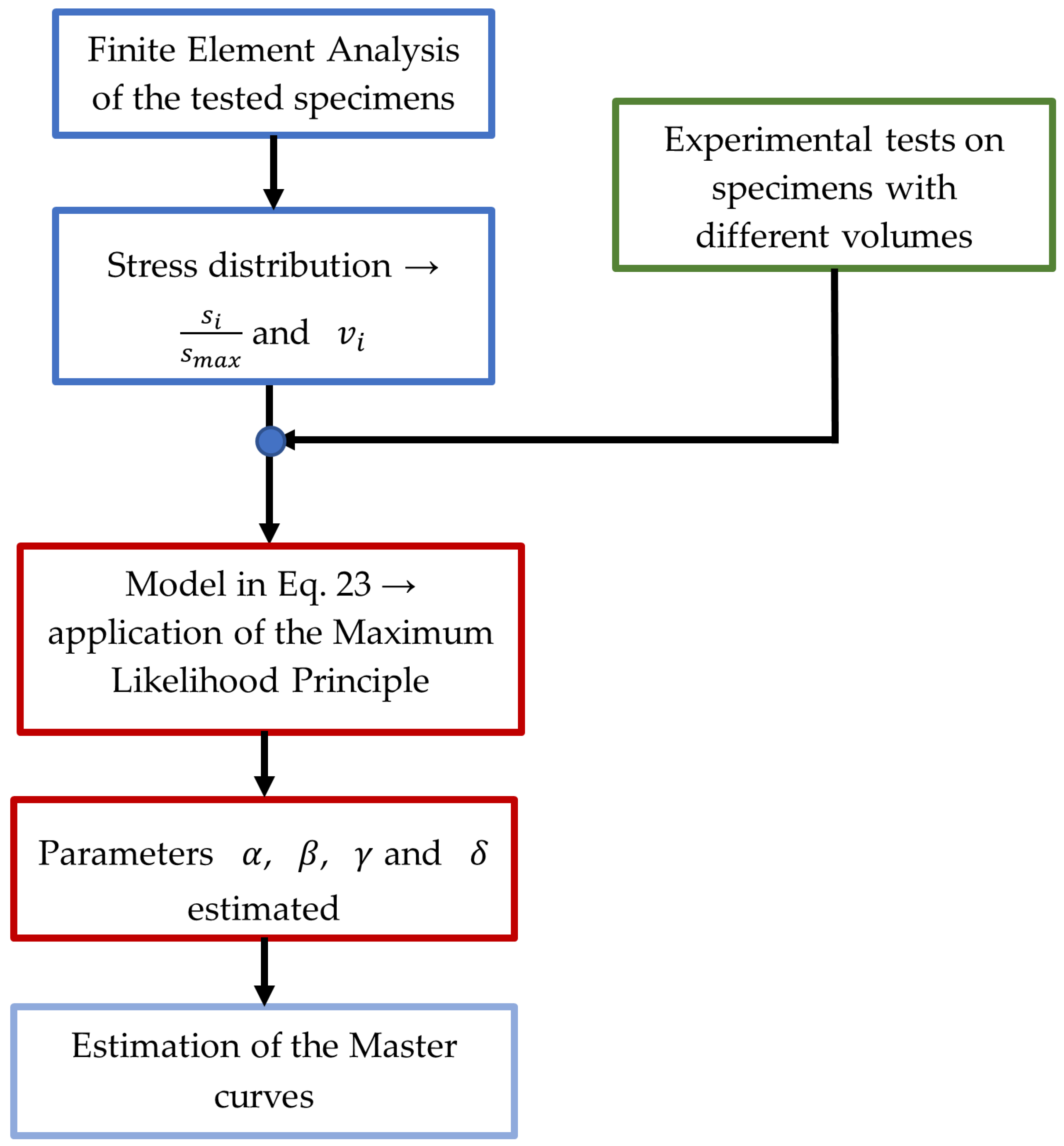

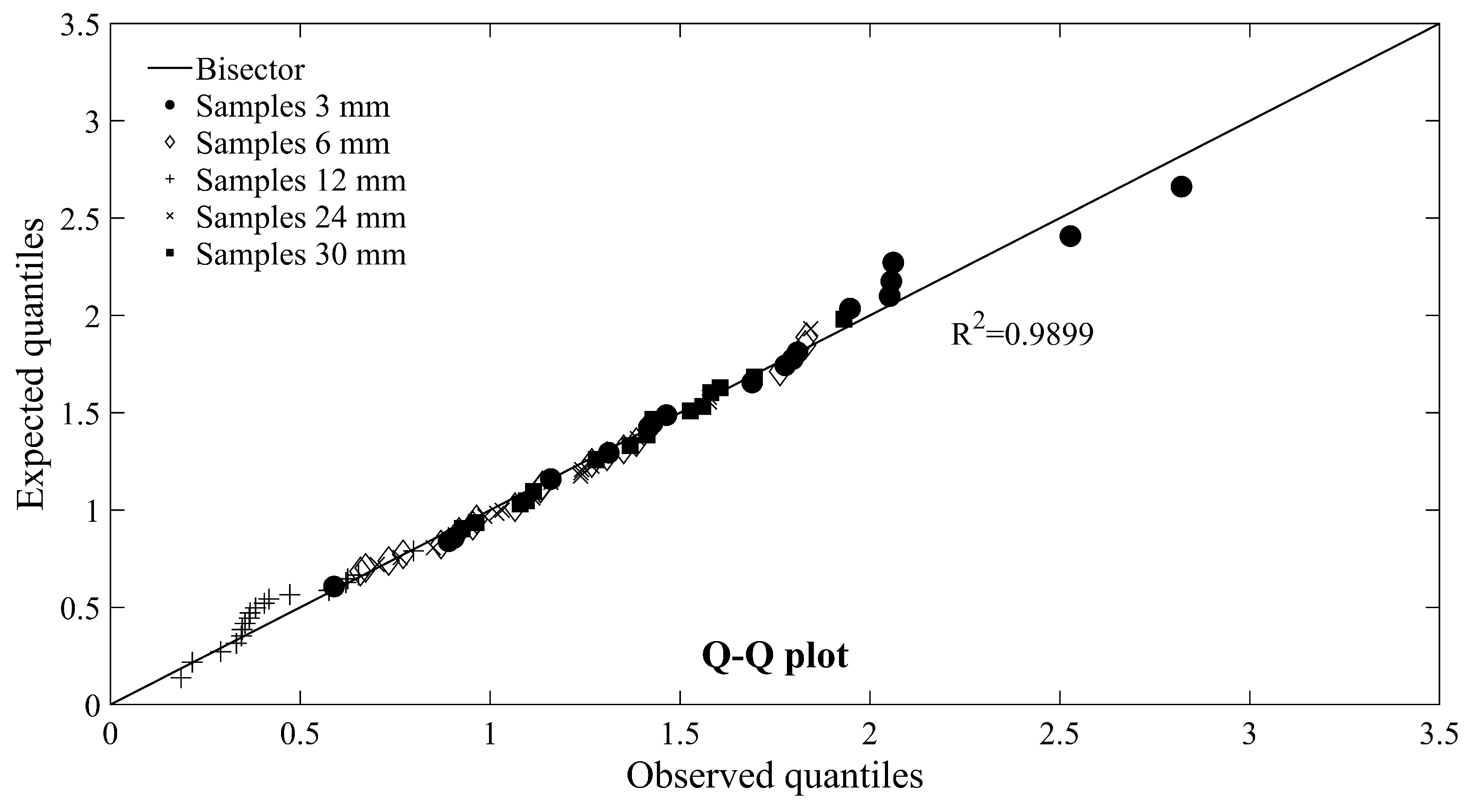
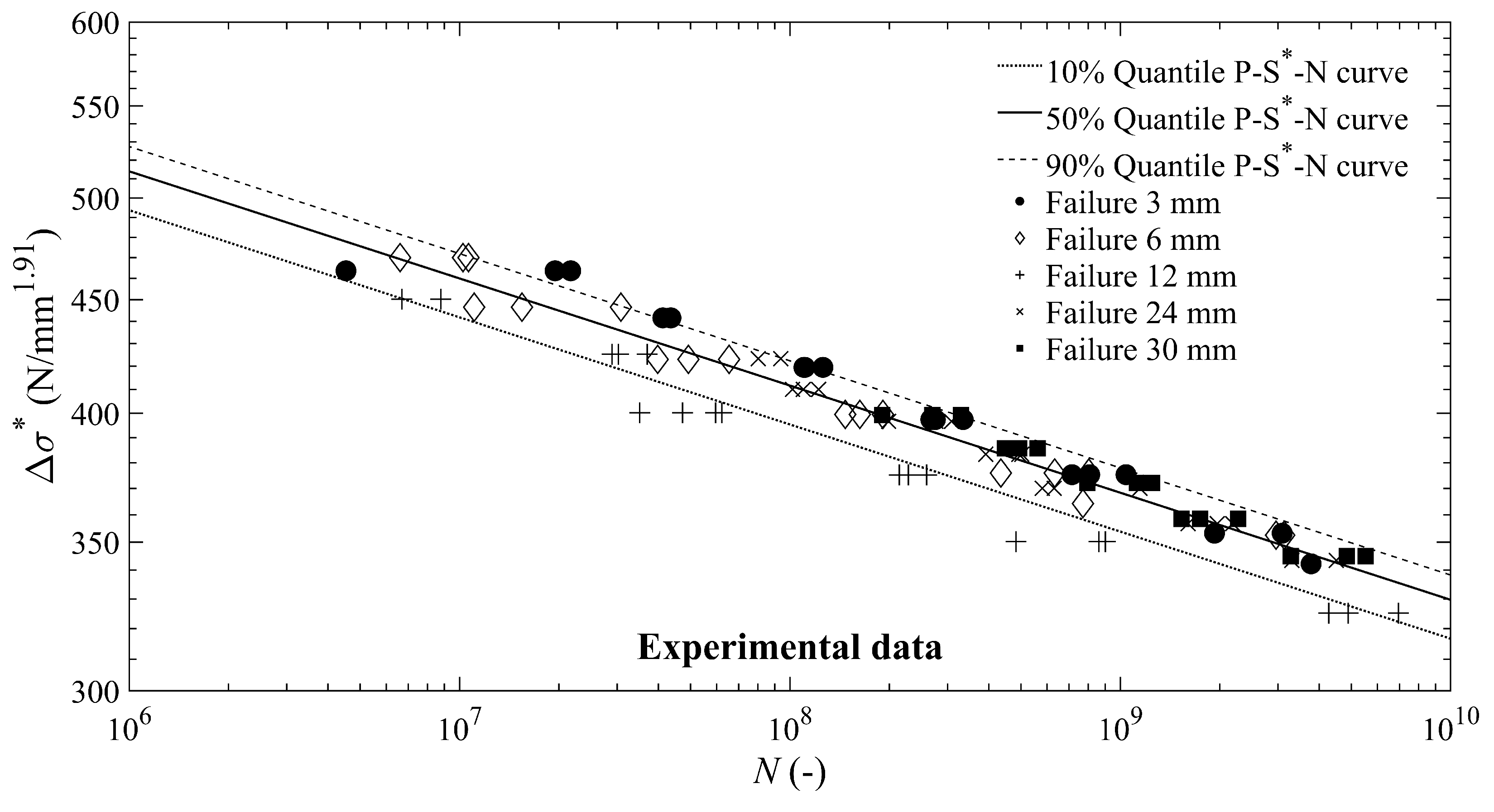
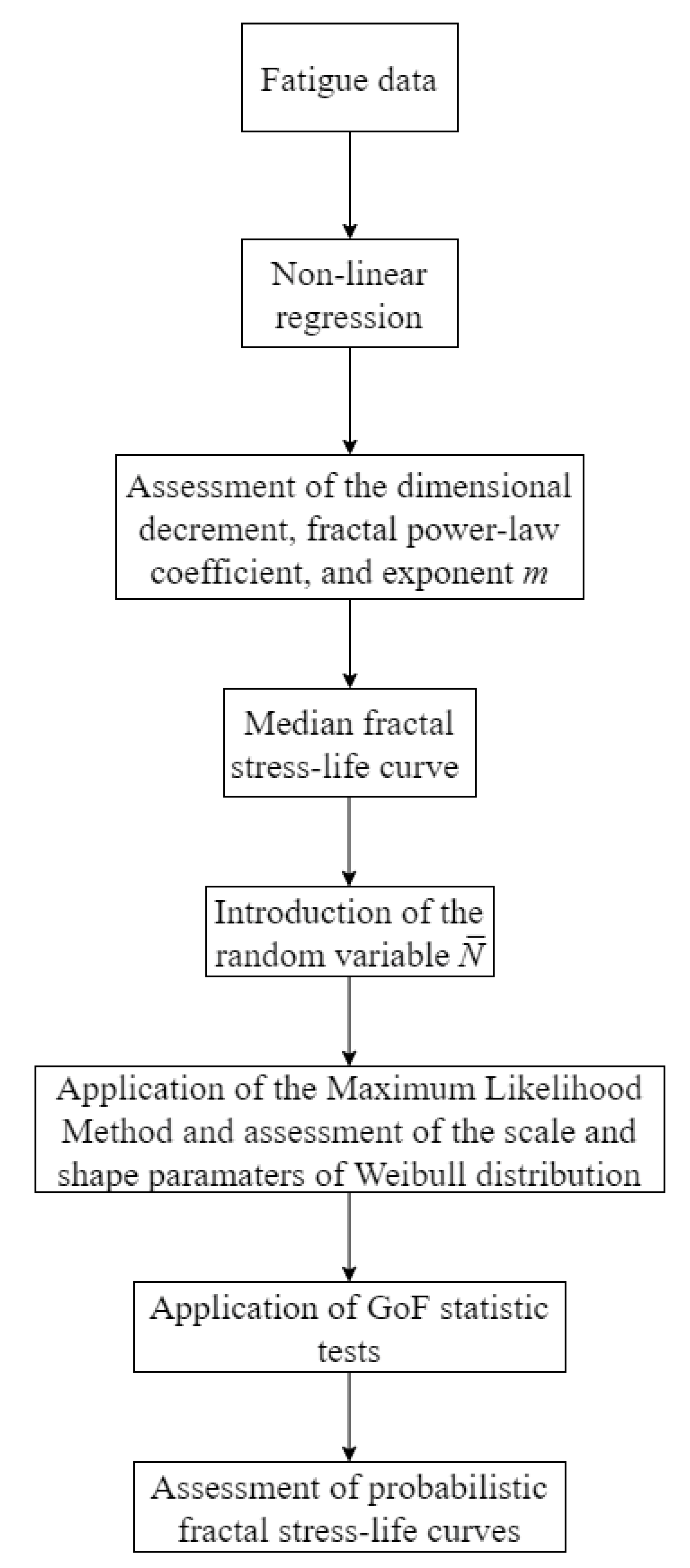
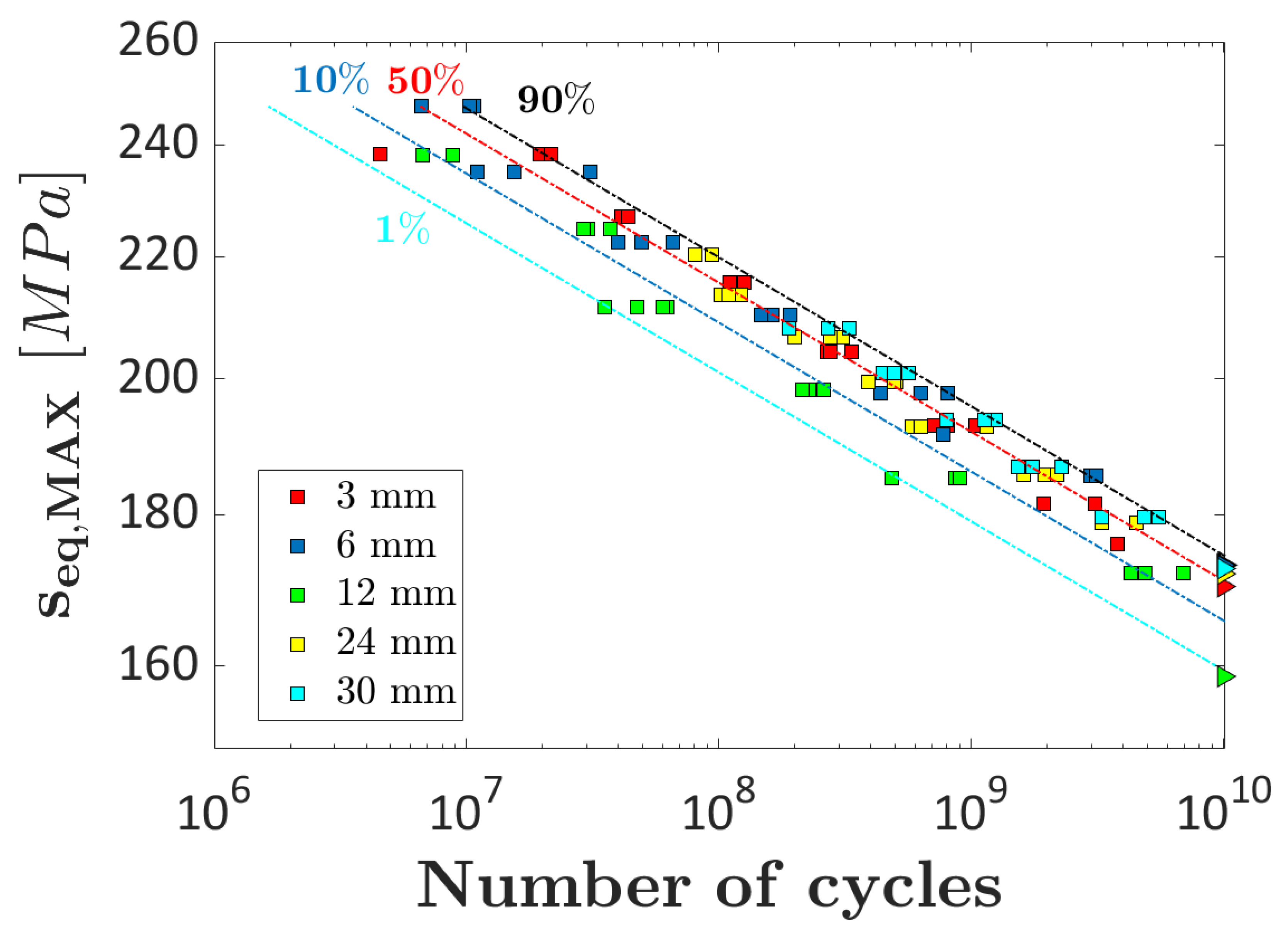
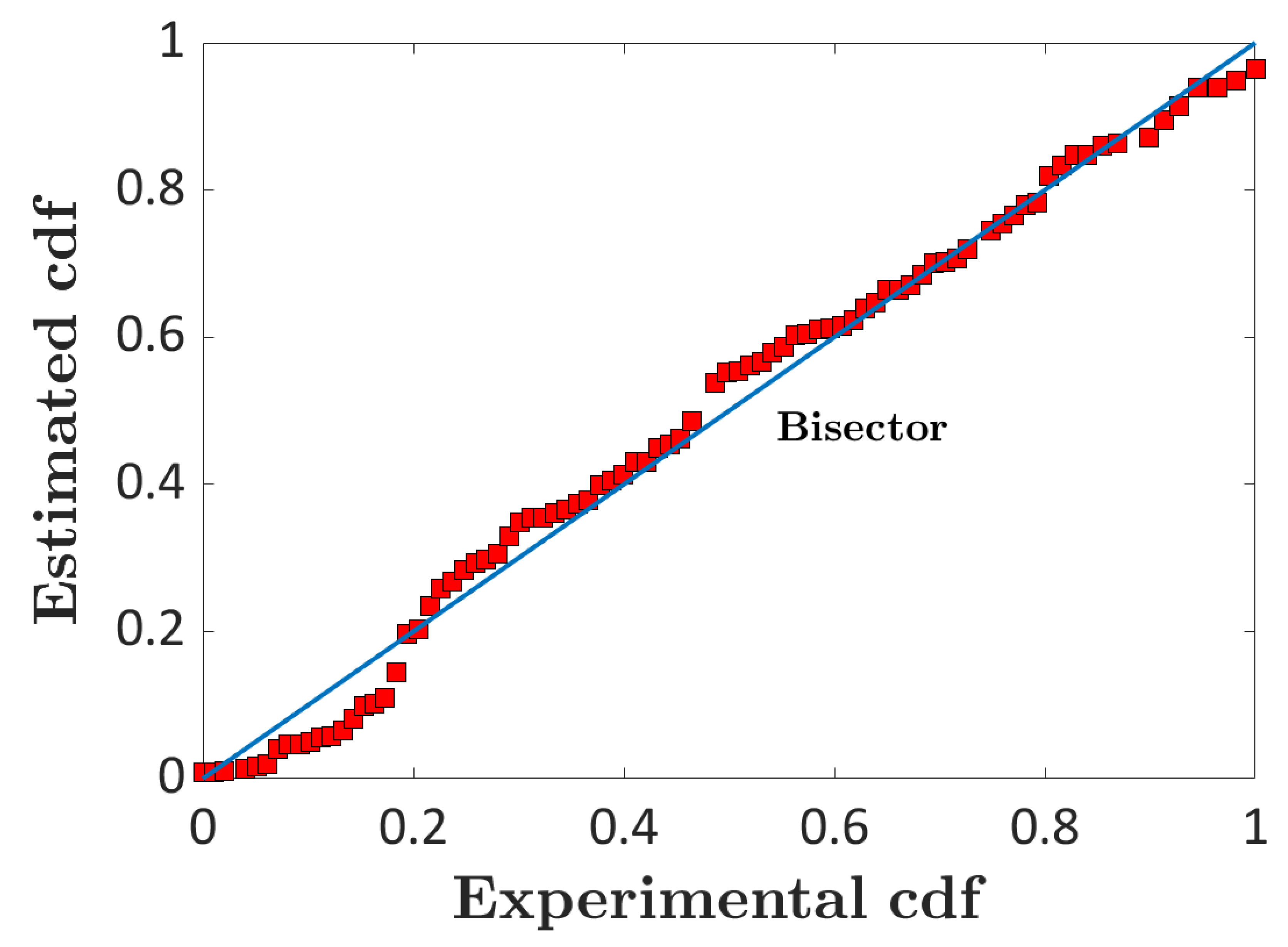
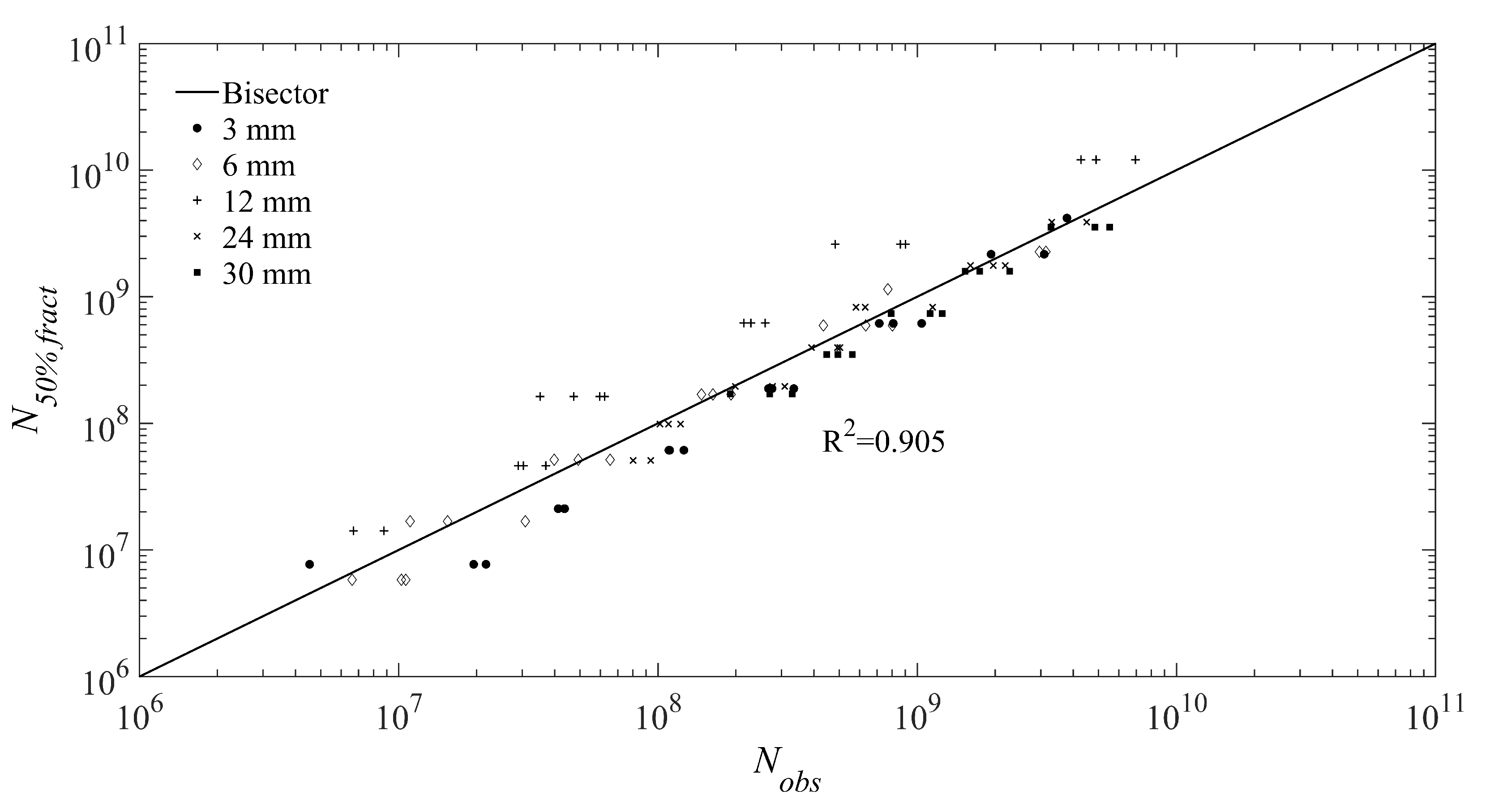
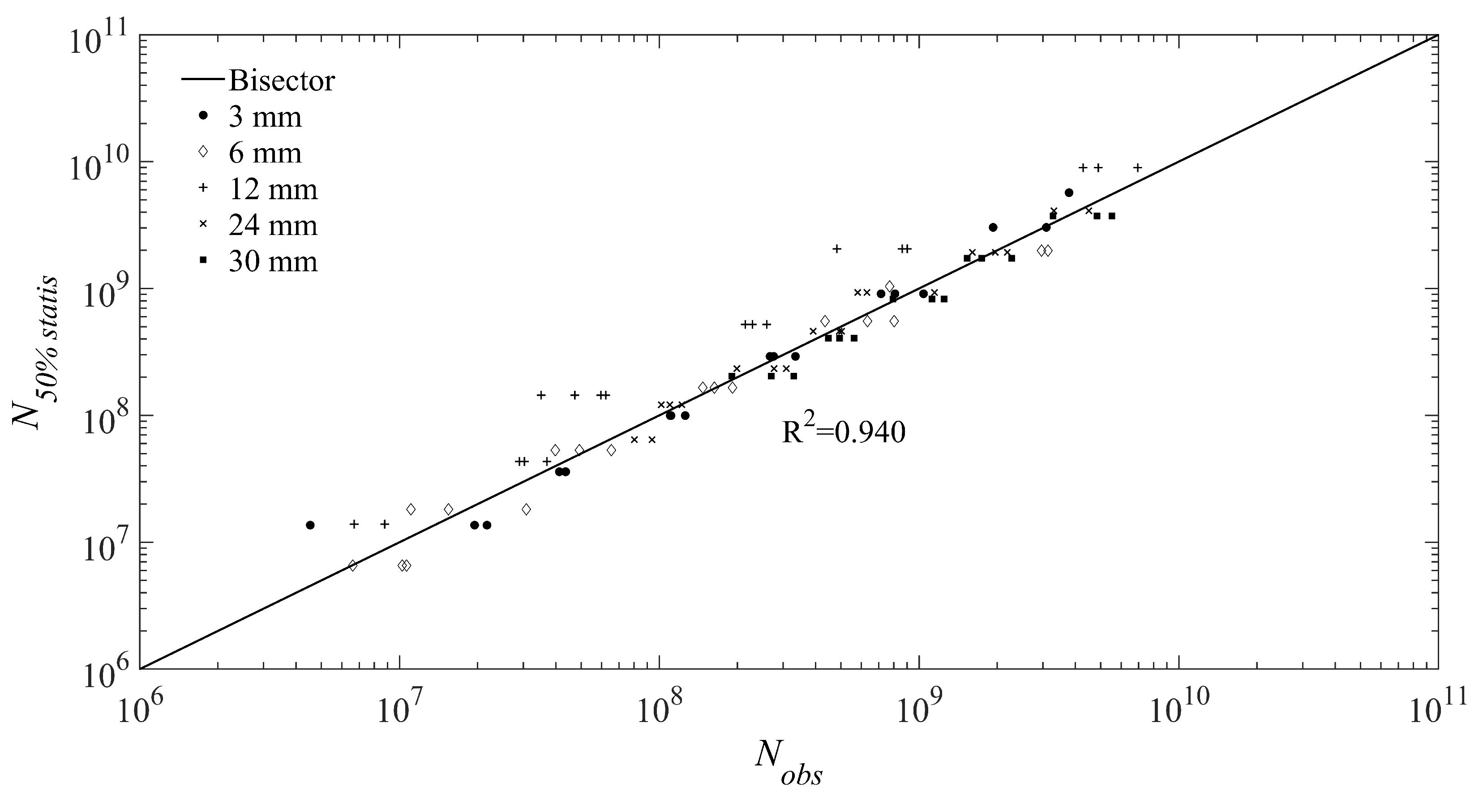
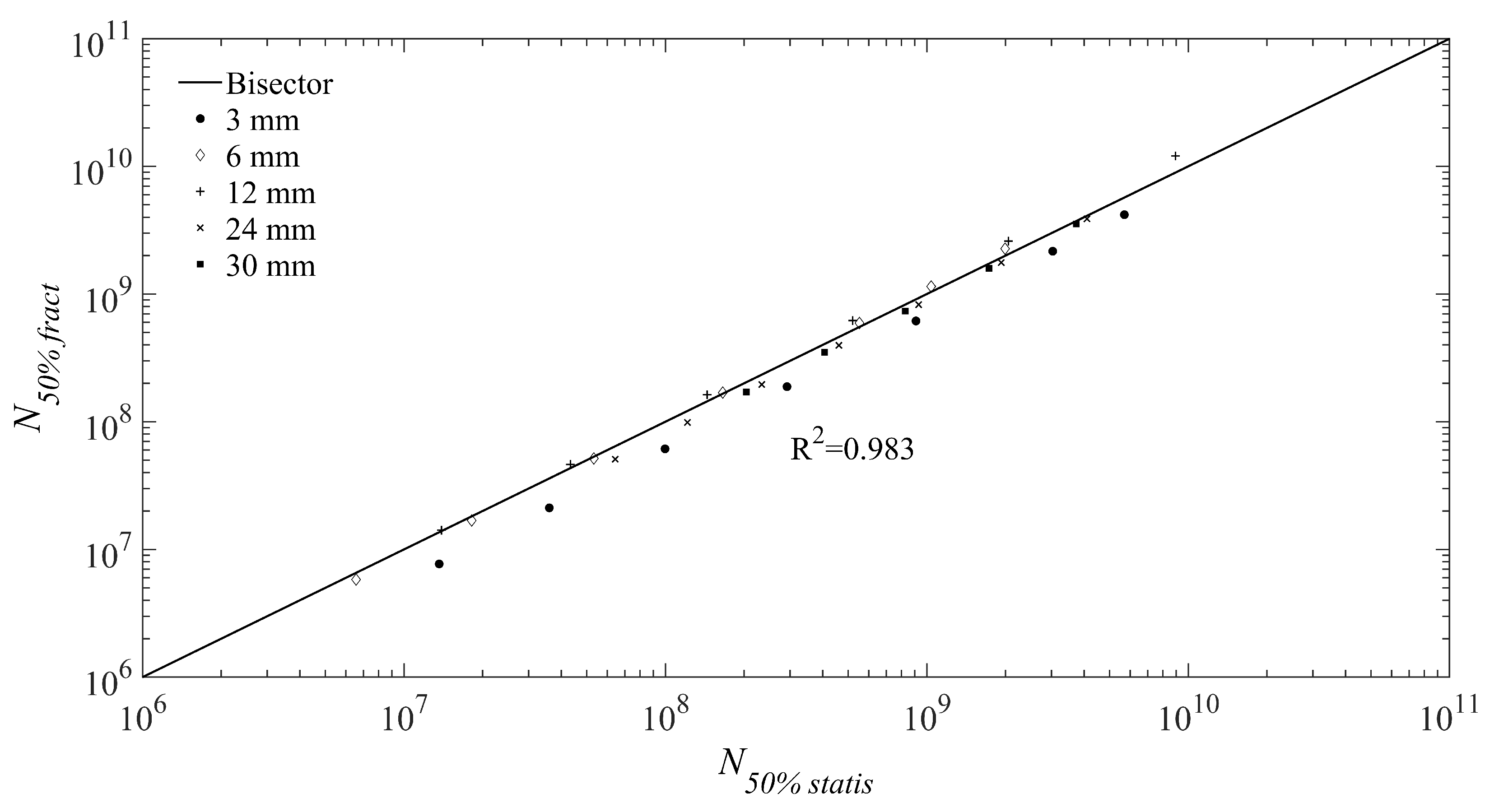
| (N mm | m | ||||
|---|---|---|---|---|---|
| 996.1 | 0.091 | 21.2 | 1.3151 | 2.0861 | 0.913 |
| GoF Statistics Tests | K-S | C-vM | A-D | |
|---|---|---|---|---|
| Actual values | 11.0000 | 0.0615 | 0.0413 | 0.3504 |
| Critical values | 21.6660 | 0.1427 | 0.2200 | 0.7529 |
Publisher’s Note: MDPI stays neutral with regard to jurisdictional claims in published maps and institutional affiliations. |
© 2022 by the authors. Licensee MDPI, Basel, Switzerland. This article is an open access article distributed under the terms and conditions of the Creative Commons Attribution (CC BY) license (https://creativecommons.org/licenses/by/4.0/).
Share and Cite
Invernizzi, S.; Paolino, D.; Montagnoli, F.; Tridello, A.; Carpinteri, A. Comparison between Fractal and Statistical Approaches to Model Size Effects in VHCF. Metals 2022, 12, 1499. https://doi.org/10.3390/met12091499
Invernizzi S, Paolino D, Montagnoli F, Tridello A, Carpinteri A. Comparison between Fractal and Statistical Approaches to Model Size Effects in VHCF. Metals. 2022; 12(9):1499. https://doi.org/10.3390/met12091499
Chicago/Turabian StyleInvernizzi, Stefano, Davide Paolino, Francesco Montagnoli, Andrea Tridello, and Alberto Carpinteri. 2022. "Comparison between Fractal and Statistical Approaches to Model Size Effects in VHCF" Metals 12, no. 9: 1499. https://doi.org/10.3390/met12091499
APA StyleInvernizzi, S., Paolino, D., Montagnoli, F., Tridello, A., & Carpinteri, A. (2022). Comparison between Fractal and Statistical Approaches to Model Size Effects in VHCF. Metals, 12(9), 1499. https://doi.org/10.3390/met12091499









